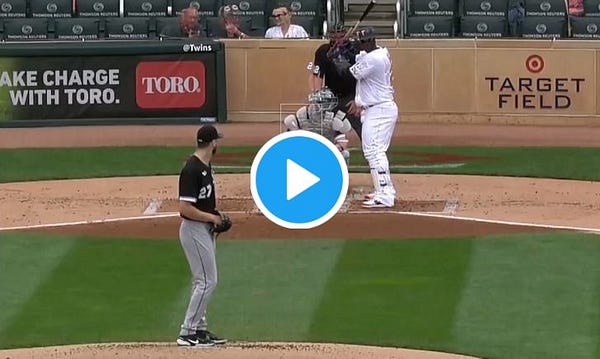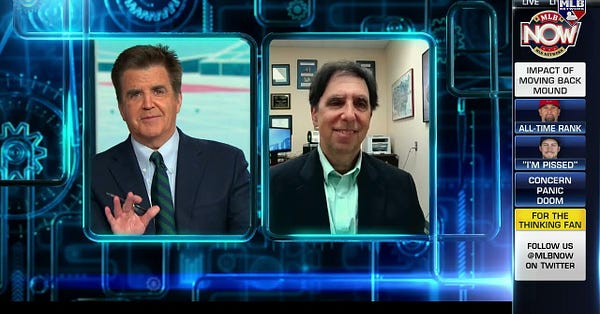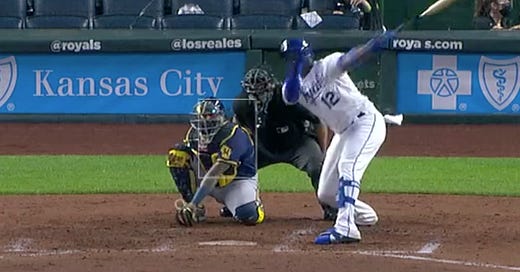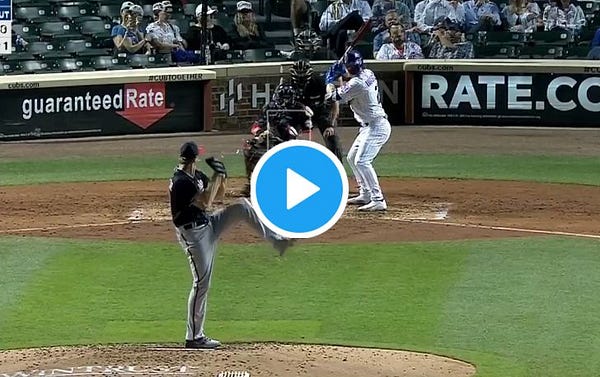A Big Picture Step Back: Why Can't Hitters Hit Anymore?
There's seemingly a no-hitter every other day and even when there's not, the storylines are all about pitchers dominating.
No sport is perfect. As an obvious fanatic about the game of baseball, I had a hard time accepting that for a long time. But the reality is that baseball is flawed just like every other sport. Things change. Guys get bigger. Guys throw harder. The game, while the same in so many ways, is also very different than what we saw even 30 years ago. Heck, it’s different than even six years ago when the Royals used a formula of putting the ball in play, running like hell and then protecting every lead that they had through six to win a World Series.
The league batting line is .236/.312/.394. Looking at the AL only because non-Shohei Ohtani pitchers don’t hit, the league line is .238/.310/.399. I didn’t look into it, but I’d assume the slight OBP and AVG-OBP decrease is because of teams walking the guy ahead of the pitcher in the NL, so that all checks out. Go back just 12 years though. The worst hitting team in the American League hit .258/.314/.402. That was the Mariners. The A’s actually had a slightly worse slugging percentage at .397.
The worst line outhit the average line in 2021. So for one thing, I think it’s important that we think about that when we realize that we might need to recalibrate what we think is a good season and what we think is a bad season. I used to give the example all the time of Angel Berroa’s rookie season OPS+ of 101 in a year he hit .287/.338/.451. So he was roughly league average with that line. In 2021, Jarrod Dyson also has an OPS+ of 101. He’s hitting .233/.324/.400. Obviously there are some flaws in that stat, but it’s just a very different game today.
Many believe that a way to fix this would be to stop allowing the shift. Some blame “launch angle” for all the offensive issues in the game. Some think they go hand in hand. The thought is that with very few holes where a guy typically hits the ball that they do everything they can to simply negate the shift by hitting the ball over the wall. They have to focus on their launch angle to do that, so that’s what’s causing all the problems. So the idea is that if you ban the shift, everything magically gets better.
I think you can tell already that I think that’s, to use a term appropriate for all ages, poppycock. In some ways, yes, the inability for so many hitters to be able to shorten up and avoid the strikeout is part of the problem. Guys absolutely do try everything they can to muscle the ball over the wall. But this, friends, is a symptom of the disease, not the disease itself.
And that’s not even fair to call it a disease because the reality of the matter is that pitchers are just too good. Hitters have such a hard time hitting because the pitching is so good that they have to try to hit home runs. The days of routinely being able to get three hits to score a run are long over with some of the arms out there today. If you don’t believe me, just spend five minutes scrolling through @PitchingNinja on Twitter. What these guys can do is incredible.
So why can’t hitters get as much better as the pitchers have? That’s a good and fair question, and I’m not sure this is the best answer, but my belief is that pitchers have an advantage over the batter at all times because they are the ones who dictate the action. The batter always has to react rather than have a chance to make the first move. And that won’t change unless they move to a tee-ball home run derby to determine an extra innings winner. I shouldn’t have said that. Now Rob Manfred has ideas.
For years, hitters have been able to react accordingly because there was only so much that pitchers can do. As humans just get bigger, it’s reasonable to expect velocity to increase, but places like Driveline started popping up with training plans to increase velocity beyond simple human growth. This is purely anecdotal, but I remember being very young and marveling at a fastball sitting at 92 or 93 from pitchers and now if you don’t throw at least that, you’re either a veteran lefty, someone who has incredible command or someone who is about to be out of the game.
But it’s not just velocity. There is technology available now that gets better seemingly each day that allows pitchers to hone in on very minute aspects of their game to get better. I’m not trying to get too deep into the weeds here, but an example is Rapsodo which can show pitchers just about everything they need to know about every pitch filmed. From here, they can make changes to increase spin rate, break and even path of pitches. One of the most obvious yet interesting changes in pitching we’ve seen over the last few years is the concept of tunneling.
It’s not complicated. At a very basic level, it’s simply keeping pitches in one “tunnel” as long as possible before the ball breaks in the way that it’s going to break. This is where Rob Friedman, aka Pitching Ninja, does such an amazing job of showing just how good pitchers are.
I mean what are you supposed to do there? There are 60 feet, six inches from the pitching rubber to home plate and at least half of that distance, it sure looked like those were the same pitch. One was actually a bit of a mistake and left hittable, but because a hitter simply can’t know what it is, he can get away with that mistake. I want to show you another one because this blew my mind.


If you’ve ever wondered why a hitter takes that pitch, this is why. Pitchers are mind bogglingly good. I’ve said a lot of words to kind or prove my original point that the problem with offense has a lot less to do with the hitters than it does with the pitchers.
So let’s go back to the symptom, and that’s what we talked about earlier of too many home runs. Well, not exactly too many home runs, but too many hitters trying to hit home runs. Of course, many of them were succeeding because the ball was obviously juiced. Whether it was intentional or not is irrelevant, but it was happening. And no matter how many times MLB tried to deny it, they sheepishly admitted to it when they discussed how they were reconfiguring the balls to fly a bit less far.
The general consensus is that the ball was juiced sometime in mid-2015, so you can probably throw that year out, but here’s a look at average fly ball distance by year since 2016:
First of all, hello 2019. Second of all, last year was so weird that it probably doesn’t mean much. So it’s the lowest distance and really more back to the 2016 ball than what we saw before. But the issue with this “new” ball is that it didn’t do anything else but decrease distance. I’m not smart enough to really understand all of it, so I’m not going to spend too much time here, but the average exit velocity on fly balls is harder than ever but the ball isn’t getting out of the park. Home runs per fly ball is back to 2017/2018 levels. Which is good on some levels.
Except the issue is that what MLB has done here is they’ve made it harder to hit a home run without making it any easier on the hitter to do anything else. So they still can’t bunch together three singles against these pitchers but now they also can’t get the ball out of the park. I’m not saying they should bring back the 2019 ball or anything, but that’s where the issue is coming in.
The question is what’s the solution and I don’t know the answer to that. One of the things they are testing in the Atlantic League this season is to move the mound back by a foot. There was a great segment on MLB Now on MLB Network about moving the mound back that you can see below. I’ll note it’s a little long, so finish reading here and then hit this up when you have a chance.


My initial thought was that it would lead to injuries. Picture the 33-year old veteran who has been throwing from this distance since high school. That’s 15-18 years and suddenly they’re forced to throw from another foot or two or whatever it is. But the studies showed that they could even move it back about three feet to be in the true center of the diamond and there wouldn’t be a health impact.
Who am I to argue with actual doctors and scientists? So that’s an interesting thought and then when you think about the benefits, it really does seem appealing. With extra time, hitters have an opportunity to identify pitches better. It will probably improve umpiring as well as they get that extra split second to see the pitch (though robot umps are coming for balls and strikes). But it has other impacts as well.
Because there’s more space between the release of the ball and it getting to the hitter, there’s more time for the pitch to move and we know that movement is at an all-time high. Does that benefit the hitter or the pitcher? I don’t know the answer to that. Maybe both, depending on the pitcher. Maybe pitchers have to actually aim for less movement to keep the ball hittable.
If there’s an extra tenth or two-tenths of a second, maybe this increases stolen bases. The stolen base is already making a bit of a comeback, but if teams have a little extra time, we’ll definitely see more steals. And if we see more steals, will we see teams focus less on hitting home runs because now it takes two hits instead of three to score a run?
Because that’s the whole point of everything here. It’s not about the fact that hitters swing for the fences. It’s about changing the environment to make them not have to swing for the fences in order to put up runs. If the game is able to make changes that give hitters more of a chance, you will likely see the return of teams keeping the line moving like we saw so much during the 2014 and 2015 runs for the Royals.
If your question here is why can’t hitters just get better and why should the league acquiesce to a group that simply won’t adjust, I really implore you to just see how good pitching is today. And also to remember that the game has changed before. This was before I was even a consideration, but in 1968, pitchers absolutely dominated. The league hit .237/.299/.340. Carl Yastrzemski led the American League with an average of just .301. That was famously the year of Bob Gibson’s 1.12 ERA and Denny McLain’s 31 wins, but it wasn’t just them.
And how did the league respond? They lowered the mound from 15 inches to 10 inches to help hitters because pitching had just gotten too good. Remember, hitters never get to start the action so they are inherently at a disadvantage. When success is not failing 65 percent of the time, you’re starting off in a hole. Sometimes the league needs to step in and help fill that hole in just a little bit. I don’t know if the answer is moving the mound back, lowering it or what, but I’ll reiterate once more that this is far more about the pitchers than about where defenders stand or the approach hitters take.
Now if you’ll excuse me, I have to prepare to watch today’s no-hitter.






You're right that the hitters have always been at a disadvantage - evidenced by the fact that they historically lose over 70% of the battles - you're also right that the pitchers are damn good.
However, to deny that the shift plays a part is inaccurate. You said yourself that the every part of the game is analyzed more than ever, part of that analysis is who to shift and where to shift. Defenses wouldn't do it if it didn't work.
Until hitters start making adjustments and hitting against the shift then mlb shouldn't do a single thing. Learn how to bunt, hit the ball oppy, play the game of knowing where the D is and where your opportunity is. Moose did it and drove his BA up and got to an All-Star level.
It's not on MLB to bail out one side of the game that is stubborn and stuck in an old-school mindset and refuses to adapt when the other side of the game has.
I do not see hitters move around in the batters box. Closer to or further away from the plate. I think if hitters were willing to make some minor adjustments in the box on an at bat to at bat situation to situation basis, they would be in better position to succeed.